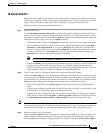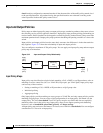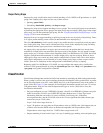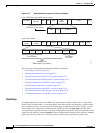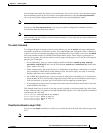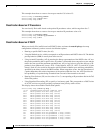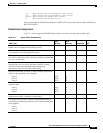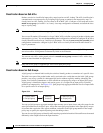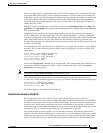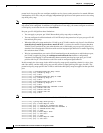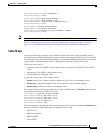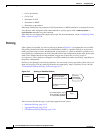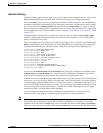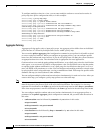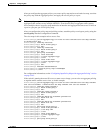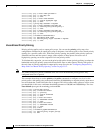
33-11
Cisco ME 3400 Ethernet Access Switch Software Configuration Guide
OL-9639-06
Chapter 33 Configuring QoS
Understanding QoS
You can use QoS groups to configure per-port, per-VLAN QoS output policies on the egress interface
for bridged traffic on the VLAN. Assign a QoS group number to a VLAN on the ingress interface by
configuring a per-port, per-VLAN input policy. Then use the same QoS-group number for classification
at the egress. Because the VLAN of bridged traffic does not change during forwarding through the
switch, the QoS-group number assigned to the ingress VLAN can be used on the egress interface to
identify the same VLAN.
Beginning with Cisco IOS Release 12.2(44)SE, you can use the cpu traffic qos [cos value | dscp value |
precedence value | qos-group value] global configuration command to configure a QoS group number for
CPU-generated traffic.
Independently you can assign QoS-group numbers at the ingress to any combination of interfaces,
VLANs, traffic flows, and aggregated traffic. To assign QoS-group numbers, configure a QoS group
marking in an input policy map, along with any other marking or policing actions required in the input
policy map for the same service class. This allows the input marking and policing functions to be
decoupled from the egress classification function if necessary because only the QoS group must be used
for egress classification.
To communicate an ACL classification to an output policy, you assign a QoS number to specify packets
at ingress. This example identifies specific packets as part of QoS group 1 for later processing in an
output policy:
Switch(config)# policy-map in-gold-policy
Switch(config-pmap)# class in-class1
Switch(config-pmap-c)# set qos-group 1
Switch(config-cmap-c)# exit
Switch(config-cmap)# exit
You use the set qos-group command only in an input policy. The assigned QoS group identification is
subsequently used in an output policy with no mark or change to the packet. You use the match
qos-group in the output policy.
Note You cannot configure match qos-group for an input policy map.
This example creates an output policy to match the QoS group created in the input policy map
in-gold-policy. Traffic internally tagged as qos-group 1 is identified and processed by the output policy.
Switch(config)# class-map out-class1
Switch(config-cmap)# match qos-group 1
Switch(config-cmap)# exit
The switch supports a maximum of 100 QoS groups.
Classification Based on VLAN IDs
With classification based on VLAN IDs, you can apply QoS policies to frames carried on a
user-specified VLAN for a given interface. Beginning with Cisco IOS software release 12.2(25)SEG, if
the switch is running the metro IP access or metro access image, you can use hierarchical policy maps
for per-VLAN classification on trunk ports. Per-VLAN classification is not required on access ports
because access ports carry traffic for a single VLAN. If you try to attach an input per-port, per VLAN
hierarchical policy to a port that is not a trunk port, the configuration is rejected.
The switch supports two policy levels: a parent level and a child level. With the QoS parent-child
structure, you can reference a child policy in a parent policy to provide additional control of a specific
traffic type. For per-port, per-VLAN QoS, the parent-level class map specifies only the VLAN match
criteria, and the child-level class maps provide more detailed classification for frames matching the



